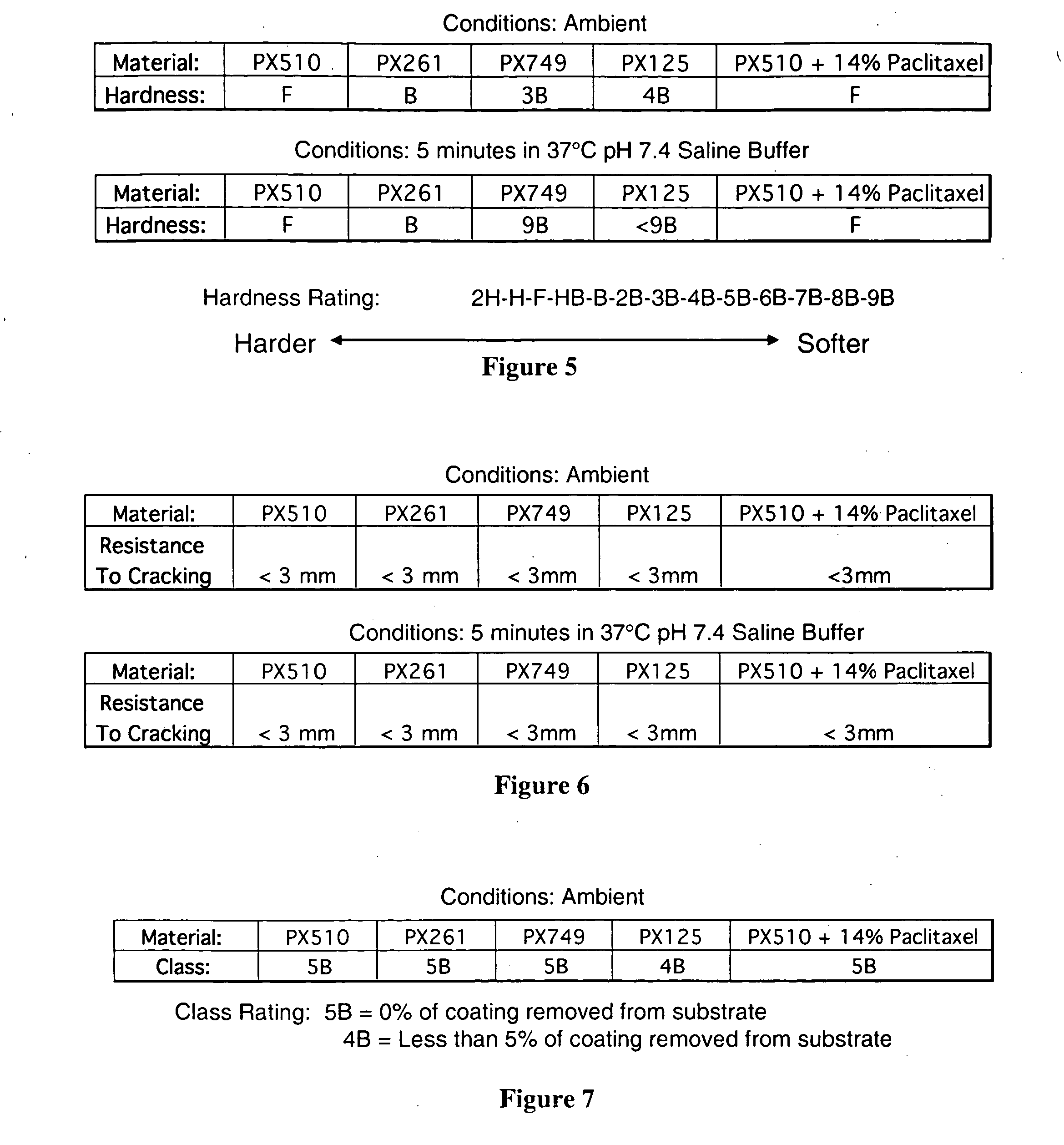Medical devices employing novel polymers
a technology of novel polymers and medical devices, applied in the field of medical devices employing novel polymers, can solve the problems of undesirable biodegradable polymer drug delivery systems, devices coated with non-biodegradable coatings, and coatings and surface technologies to date are typically non-biodegradabl
- Summary
- Abstract
- Description
- Claims
- Application Information
AI Technical Summary
Benefits of technology
Problems solved by technology
Method used
Image
Examples
example 1
[0391] Data obtained for 316 L stainless steel coupons with a 30 mm×20 mmט5 μm thick coating of therapeutic polymer composed of salicylic acid and adipic acid (PX510), suberic acid (PX261), sebacic acid (PX749), or dodecandoic acid (PX125), a copolymer formed by polymerizing a 50:50 mole percent mixture of monomers composed of salicylic acid and adipic and suberic acids, respectively (PX721), or PX510 or PX749 admixed with 14% of the anti-proliferative agent paclitaxel. FIGS. 5 and 6 present data for hardness and flexibility, respectively, obtained using accepted ASTM methods. FIG. 7 presents data for adhesion between the polymerized drugs and the coupons obtained using an accepted ASTM method. FIG. 8 presents data for the generation of salicylic acid into an incubating solution of pH 7.4 phosphate buffered saline (PBS) maintained at 37° C., expressed as either the mass of salicylic acid generated per day (FIG. 8a) or the cumulative mass of salicylic acid generated (FIG. 8b). FIG. ...
example 2
[0392] Data obtained for therapeutic polymer composed of salicylic acid and adipic acid (PX510), suberic acid (PX261), sebacic acid (PX749), or a copolymer formed by polymerizing a 50:50 mole percent mixture of monomers composed of salicylic acid and adipic and suberic acids, respectively (PX721). FIG. 10 presents data for the thermomechanical properties, including glass transition temperature (Tg), tensile modulus, yield strength, and ultimate elongation (also known as the elongation at failure), as measured using differential scanning calorimetry (DSC) and dynamic mechanical analysis (DMA). Data for DMA was obtained using a Perkin Elmer DMA 7e for pressed films with dimensions of approximately 1 cm length×3 mm width×0.8 mm thickness. These data demonstrate that the thermomechanical properties of a polymerized drug can be varied by varying the number of atoms of carbon in the dicarboxylic acid linker.
example 3
[0393] Data obtained for wires coated with the therapeutic polymer PX510 composed of salicylic acid and adipic acid admixed with 1.8% of the immunosuppresive agent sirolimus. FIG. 11 presents data for the simultaneous generation of salicylic acid and release of sirolimus into an incubating solution of pH 7.4 PBS, containing 25% ethanol and maintained at 28° C., expressed as the cumulative mass of salicylic acid generated. These data demonstrate that simultaneous generation of salicylic acid and release of sirolimus can be achieved by admixing sirolimus into a polymerized drug of salicylic acid.
PUM
| Property | Measurement | Unit |
|---|---|---|
| Time | aaaaa | aaaaa |
| Time | aaaaa | aaaaa |
| Thickness | aaaaa | aaaaa |
Abstract
Description
Claims
Application Information
 Login to View More
Login to View More - R&D
- Intellectual Property
- Life Sciences
- Materials
- Tech Scout
- Unparalleled Data Quality
- Higher Quality Content
- 60% Fewer Hallucinations
Browse by: Latest US Patents, China's latest patents, Technical Efficacy Thesaurus, Application Domain, Technology Topic, Popular Technical Reports.
© 2025 PatSnap. All rights reserved.Legal|Privacy policy|Modern Slavery Act Transparency Statement|Sitemap|About US| Contact US: help@patsnap.com



